Related Research Articles
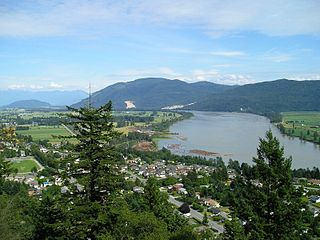
The Fraser River is the longest river within British Columbia, Canada, rising at Fraser Pass near Blackrock Mountain in the Rocky Mountains and flowing for 1,375 kilometres (854 mi), into the Strait of Georgia just south of the City of Vancouver. The river's annual discharge at its mouth is 112 cubic kilometres (27 cu mi) or 3,550 cubic metres per second (125,000 cu ft/s), and it discharges 20 million tons of sediment into the ocean.

The following is an alphabetical list of articles related to the Canadian province of British Columbia.

The Stó꞉lō, alternately written as Sto꞉lo, Stó:lô, or Stó:lõ, historically as Staulo or Stahlo, and historically known and commonly referred to in ethnographic literature as the Fraser River Indians or Lower Fraser Salish, are a group of First Nations peoples inhabiting the Fraser Valley and lower Fraser Canyon of British Columbia, Canada, part of the loose grouping of Coast Salish nations. Stó꞉lō is the Halqemeylem word for "river". The Stó꞉lō are the river people. The first documented reference to these people as "the Stó꞉lō" occurs in Catholic Oblate missionary records from the 1880s. Prior to this, references were primarily to individual tribal groups such as Matsqui, Ts’elxweyeqw, or Sumas.

The Albion Ferry was a passenger and vehicle ferry service that sailed on the Fraser River between Albion and Fort Langley in the Lower Fraser Valley region of British Columbia, Canada from June 2, 1957, until July 31, 2009.

The K-class ferries are a group of similarly designed ferries operated by both BC Ferries and TransLink in British Columbia, Canada.

Fort Langley is a village community in Township of Langley, British Columbia, Canada. It has a population of approximately 3,400 people. It is the home of Fort Langley National Historic Site, a former fur trade post of the Hudson's Bay Company. Lying on the Fraser River, Fort Langley is at the northern edge of the Township of Langley.
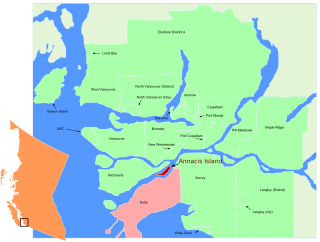
Annacis Island is a narrow island under the jurisdiction of City of Delta in Lower Mainland, British Columbia, located just downstream of the south arm of the Fraser River bifurcation between Lulu Island to the north and the Delta peninsula to the south. The island is now mostly an industrial zone, and contains one of Metro Vancouver's secondary wastewater treatment plants, the Annacis Island Wastewater Treatment Plant. The island is also home to the British Columbia Institute of Technology's Annacis Island campus.
Barnston Island is an unincorporated island located in the Greater Vancouver metropolitan area of British Columbia, Canada. Most of the island is part of Metro Vancouver Electoral Area A; the remainder is Barnston Island Indian Reserve No. 3, which is outside Electoral Area A limits and is under the governance of the Katzie First Nation, headquartered across the river at their main reserve in Pitt Meadows. Although the island is unincorporated and not officially part of any municipality, mailing addresses on the island use Surrey as the city name.
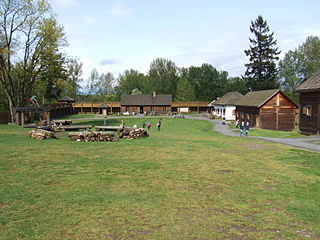
Fort Langley National Historic Site, commonly shortened to Fort Langley, is a former fur trading post of the Hudson's Bay Company in the community of Fort Langley of Langley, British Columbia, Canada. The national historic site sits above the banks of the Bedford Channel across McMillan Island. The national historic site contains a visitor centre and a largely reconstructed trading post that contains ten structures surrounded by wooden palisades.
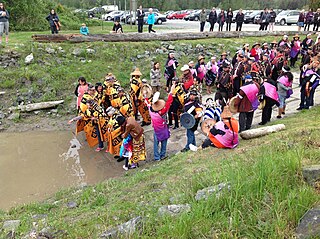
Kwantlen First Nation is a First Nations band government in British Columbia, Canada, located primarily on McMillan Island near Fort Langley. The Kwantlen people traditionally speak hən̓q̓əmin̓əm̓, the Downriver dialect of Halkomelem, one of the Salishan family of languages.
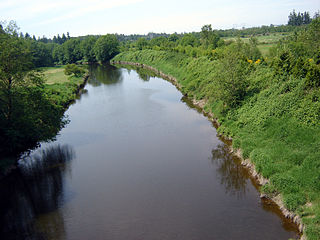
The Nicomekl River springs from the ground in Langley, British Columbia and travels west through the city to Surrey's Crescent Beach, where it empties into Mud Bay, the northernmost section of the Boundary Bay of the Strait of Georgia. It has a total length of 34 km, with a drainage area of 149 km2.
James McMillan was a fur trader and explorer for the North West Company and Hudson's Bay Company. He led some of the earliest surveys of the lower Fraser River and founded Fort Langley for the HBC in 1827, and was its first Chief Trader.

The Tsawwassen First Nation is a First Nations government whose lands are located in the Greater Vancouver area of the Lower Mainland of British Columbia, Canada, close to the South Arm of the Fraser River and just north of the international boundary with the United States at Point Roberts, Washington. Tsawwassen First Nation lists its membership at 491 people, nearly half of whom live on the lands.
Albion, British Columbia is a neighbourhood in Maple Ridge, British Columbia and is one of several small towns incorporated within the municipality at its creation. It is the oldest non-indigenous community of the district's settlements, and is only slightly younger than Fort Langley, adjacent across the Fraser River, and Kanaka Creek, which is just to the west and lies along the creek of the same name. Its official definition is the area bounded by the Fraser River, Kanaka Way, and 240th Street, but in its historic sense it means the community centred on and flanking 240th Street and adjoining areas along the Fraser River waterfront and around the Maple Ridge Fairgrounds, while along Kanaka Way and also on the near bank of Kanaka Creek, the creek, is historically the community of Kanaka Creek. Burgeoning newer home construction east of 240th Street near the Lougheed Highway is also often referred to as part of Albion.

The Bedford Channel is a small side channel of the Fraser River near the north end of the Township of Langley, on the south side of McMillan Island. The pair of islands—Brae Island and McMillan Island that protect the riverfront of Fort Langley, British Columbia are reached by the bridge that crosses the Bedford Channel on the way to the now-closed Albion Ferry terminal and the main reserve community of the Kwantlen First Nation on McMillan Island. The Bedford name has been used in the name of a new housing development in the town of Fort Langley.
Whonnock is a rural, naturally treed, and hilly community on the north side of the Fraser River in the eastern part of the City of Maple Ridge, British Columbia, Canada. It is approximately 56 kilometres east of Downtown Vancouver on the Lougheed Highway Whonnock shares borders with three other Maple Ridge communities. To the west the borders are 256th Street with Albion and upper Kanaka Creek with Webster's Corners. To the east Whonnock Creek forms the border with Ruskin. To the north is the municipal border and to the south the Fraser River.
Kanaka Creek is an historic rural residential area located within Maple Ridge, British Columbia, Canada, along the banks of the creek of the same name just east of the district's main town and commercial core of Haney. Just east is Albion and immediately across the Fraser River is Derby or "Old Fort Langley", upstream from which and opposite Albion is Fort Langley. Kanaka Creek was settled by Hawaiian natives in the employ of the Hudson's Bay Company, known as Kanakas, often with local indigenous, usually Kwantlen, wives. Once a thriving community linked closely to the affairs of the fort, like the rancherie outside Fort Vancouver, Kanaka Creek dwindled somewhat when the fort was located further upstream, although some of the original families stayed on for decades. The area has long since been subdivided and is a suburban neighbourhood now, with Kanaka Creek Road, along the creek's west bank, the main arterial, which like the creek runs generally northeast, finally becoming 232nd Street to connect to the Dewdney Trunk Road. Upstream, to the northeast, is Kanaka Creek Regional Park and street connections to Webster's Corners and 240th Street. Although mostly suburban the neighbourhood retains a greenbelt quality because of the protection of the creek by its park and as a salmon spawning stream, and there are still farms operating in some parts of the area.
Nicomen Island is an island in the Fraser Valley region of southwestern British Columbia. Nicomen Mountain in the Douglas Ranges lies to the north across Nicomen Slough. Chilliwack Mountain lies to the south across the Fraser River. Adjacent to the northeast is Skumalasph Island. Dewdney, which by road is about 11 kilometres (7 mi) east of Mission, extends onto the northwestern end of the island. Deroche, which by road is about 29 kilometres (18 mi) west of Agassiz extends onto the northeastern end.
Glover Road is a primary road in Langley, British Columbia which runs from southwest to northeast North-South from the Fraser Highway in downtown Langley to the Fraser River in Fort Langley, travelling over British Columbia Highway 1 and through the community of Milner, British Columbia. The road is 11 km (7 mi) in length and mostly two lanes wide with some divided four lane sections. It is notable as the primary road in and to the village of Fort Langley and as being concurrent for some of its length with British Columbia Highway 10. Beyond Fort Langley, it crosses the Jacob Haldi Bridge onto McMillan Island and terminates at the decommissioned Albion Ferry dock within the lands of the Kwantlen First Nation. The Glover Road overpass is a six-span, two-lane structure permitting access across Trans-Canada Highway. The underpass received an overheight-warning system, the second in the province, following damage from three collisions in three years.
The Salmon River is a small river in the Township of Langley in the Lower Mainland region of British Columbia, Canada, flowing northwest then northeast to enter Bedford Channel, which separates McMillan Island from Fort Langley, which is just southwest.
References
- ↑ "BC Geographical Naming". Archived from the original on 2011-07-16. Retrieved 2010-12-14.
- ↑ BC Names/GeoBC entry "McMillan Island"
- ↑ "McMillan Island 2006 Census Profile" (PDF). BC Stats. Retrieved 2010-01-16.
- ↑ "Formation of Fraser River Delta". BC School District 36. Retrieved 2010-12-14.
- ↑ McMillan / Brae : The Evolution of an Island
- ↑ "Geography - Fort Langley". Tourism BC. Archived from the original on 2011-09-27. Retrieved 2010-12-14.
- ↑ Brae Island Regional Park Management Plan
- ↑ "Community Profile". Statistics Canada. Retrieved 2017-09-15.
- ↑ "Connectivity Profile". Indian and Northern Affairs Canada. Archived from the original on 2011-06-24. Retrieved 2010-12-14.
- ↑ Akrigg, G.P.V.; Akrigg, Helen B. (1986), British Columbia Place Names (3rd, 1997 ed.), Vancouver: UBC Press, ISBN 0-7748-0636-2
- ↑ "Albion Ferry to Cease Operation". Translink. Archived from the original on 2009-12-13. Retrieved 2010-01-16.
Coordinates: 49°10′35″N122°34′12″W / 49.17639°N 122.57000°W